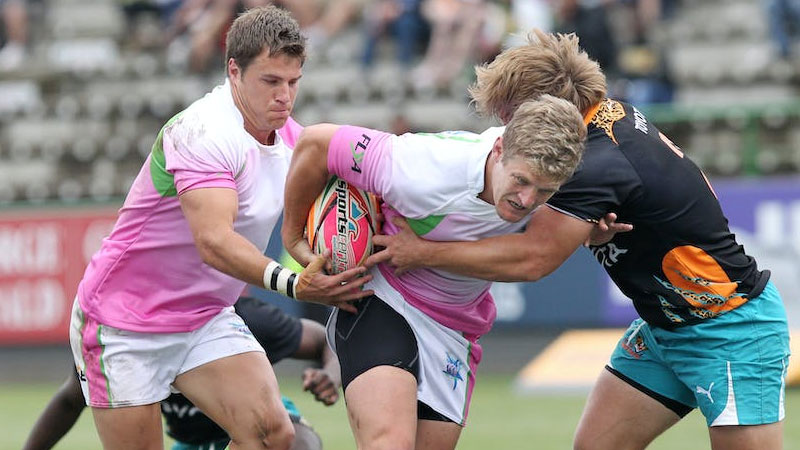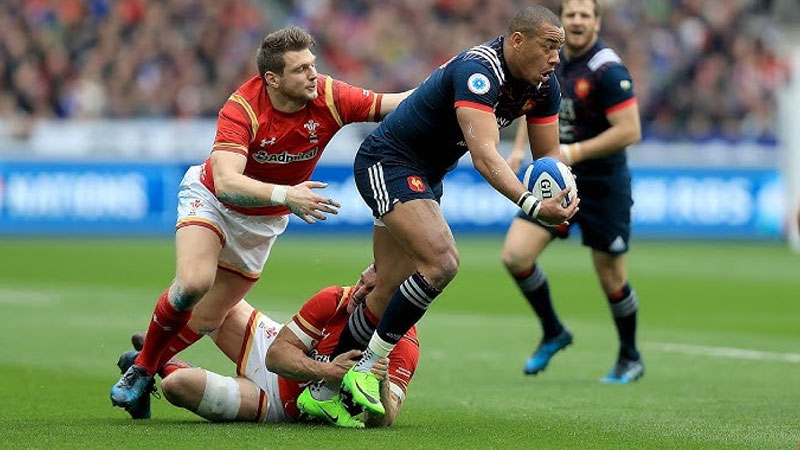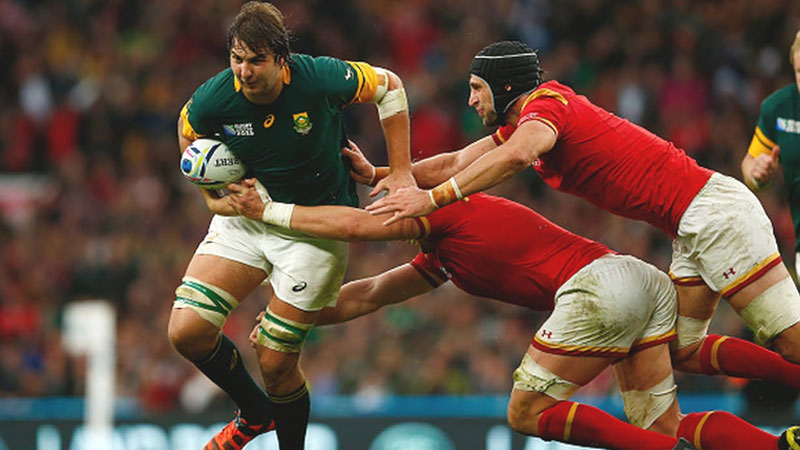In the fast-paced and physically demanding world of rugby, mastering various techniques is crucial for success on the field. Among these techniques, the stiff arm stands out as a powerful and effective maneuver for ball carriers.
A well-executed stiff arm allows a player to fend off would-be tacklers, creating precious space and maintaining possession of the ball. This skill relies on precise timing, proper body positioning, and strategic use of force.
In this guide, we will delve into the art of stiff-arming in rugby, offering insights on how to execute it effectively, adhere to the rules, and gain a competitive advantage while ensuring player safety.
What Does Stiff Arm Mean in Rugby?
In rugby, a “stiff arm” refers to a technique used by a ball carrier to fend off or push away a tackler who is attempting to make a tackle. It involves extending one arm with an open hand and using it to create space between the ball carrier and the tackler.
The aim is to prevent the tackler from making contact or to create separation for the ball carrier to continue their run. The term “stiff arm” comes from the idea of keeping the arm stiff and extended to push the tackler away.
It’s a legal maneuver when executed within the rules and guidelines of the sport, but it must be done without targeting the tackler’s head or neck, which is considered dangerous and illegal play.
How to Stiff Arm in Rugby?
Stiff-arming, a fundamental skill in rugby, is a technique used by ball carriers to fend off tacklers and gain precious yards while maintaining possession of the ball.
Executed effectively, it can create space and keep defenders at bay.
Here’s a comprehensive guide on how to stiff-arm in rugby:
Body Position

Before attempting a stiff arm, it’s crucial to establish the right body position. As you approach a tackler, maintain a balanced and powerful running stance.
Slightly bend your knees, lower your hips, and lean forward. This position sets the foundation for effective stiff-arming by providing stability and power.
Ball Security
Initially, ensure that you have a firm grip on the rugby ball with both hands. Protecting the ball is paramount, as losing possession can be costly in a game where turnovers can change the tide of play.
Hand Selection
Decide which hand you will use for the stiff arm. Typically, rugby players use their non-dominant hand (the one farthest from the tackler) to secure the ball while reserving their dominant hand for the stiff arm.
Arm Position
Raise your dominant arm, forming a slightly cupped hand shape with your fingers together. Maintain a slight bend in your elbow for flexibility and control.
Timing is Crucial
The key to a successful stiff arm lies in its timing. Wait until the tackler is within striking range before extending your arm. Precision and patience are essential to maximize the effectiveness of this move.
Target Zone
Aim your stiff arm at the tackler’s upper chest or shoulder area. Avoid making contact with the head or neck, as this can result in penalties or injuries.
Focusing on the chest or shoulder allows you to create separation without endangering your opponent.
Forceful Push
As the tackler approaches, deliver a forceful push with your extended arm into their chest or shoulder. Simultaneously, lean into the contact to add extra power.
This combination of your forward momentum and the strength of your stiff arm should create space between you and the tackler.
Accelerate Away
Immediately after executing the stiff arm, accelerate away from the tackler. Utilize your speed and agility to exploit the gap you’ve created, making it challenging for the tackler to recover.
Maintain Awareness
Keep your head up and stay alert to other defenders closing in. Be prepared to pass the ball to a teammate or continue your run if you can’t break free.
Awareness of your surroundings is crucial for making the most of the situation.
Practice and Repetition
Perfecting the stiff arm takes practice and repetition. Consistently work on your timing, hand placement, and footwork during training sessions to become proficient.
A well-executed stiff arm can be a game-changer, so invest time in honing this valuable skill within the rules and spirit of the game.
What is Rugby Stiff Arm Rules?

In rugby, the stiff arm, also known as the end, is a technique used by ball carriers to fend off tacklers and create space. However, the use of the stiff arm is regulated by specific rules to maintain player safety and uphold fair play.
Here are the key rules regarding the stiff arm in rugby:
Contact Zone
The stiff arm can only be used between the shoulders and the waist of the tackler. It should never be aimed at the tackler’s head or neck. Striking an opponent’s head or neck with a stiff arm is illegal and can lead to penalties or disciplinary action.
Open Hand
When using the stiff arm, players must keep their hand open, with fingers extended and not clenched into a fist. The intention is to push the tackler away, not to punch or strike them with a closed fist.
No Swinging Arms
The stiff arm should not involve any swinging or wind-up motion. It should be a controlled, forceful extension of the arm to fend off the tackler while maintaining sportsmanship.
Continuous Motion
The stiff arm should be part of a continuous motion, and it should not involve a stoppage or hesitation. It should flow naturally with the player’s running and evasion movements.
Balance and Control
Ball carriers using the stiff arm must maintain balance and control throughout the move. Using the stiff arm to intentionally knock a tackler to the ground is not allowed.
Avoiding Dangerous Play
Any stiff arm that is considered dangerous, reckless, or excessive can result in penalties, warnings, or even more severe sanctions against the offending player.
The referee has the discretion to assess the situation and make appropriate decisions.
Referee’s Judgment
The referee plays a crucial role in enforcing stiff arm rules. Their interpretation of the situation and the player’s intent can influence whether an action is deemed legal or illegal.
Players should respect the referee’s decisions on the field.
Player Safety
Player safety is a top priority in rugby. The rules surrounding the stiff arm are designed to minimize the risk of injury to both the ball carrier and the tackler.
Why is the Stiff Arm So Effective in Rugby?

The stiff arm is a remarkably effective technique in rugby for several compelling reasons, making it a valuable tool in the arsenal of ball carriers:
Maintains Ball Possession
In rugby, maintaining possession of the ball is paramount. The stiff arm enables the ball carrier to fend off tacklers while securely holding onto the ball.
This prevents turnovers and keeps the team’s offensive play intact.
Creates Space
One of the most prominent advantages of the stiff arm is its capacity to create space. By extending one’s arm and pushing the tackler away, the ball carrier gains precious room to maneuver.
This additional space can be instrumental in evading tacklers, advancing down the field, and ultimately increasing the chances of scoring.
Fends Off Tacklers
The stiff arm is a powerful defensive maneuver. It makes it challenging for tacklers to get close enough to execute a successful tackle, especially when faced with larger or more formidable opponents.
It serves as a physical barrier that defenders must overcome.
Maintains Momentum
Unlike traditional tackles, where the ball carrier is often brought to a halt or pushed backward, the stiff arm allows the player to preserve their forward momentum.
This is vital for keeping the attack moving and gaining valuable yardage.
Versatility
The stiff arm is a versatile technique that can be adapted to various game situations. Whether it’s used to fend off tacklers, create space for passing the ball to a teammate, or break free from a tackle attempt, its adaptability is invaluable.
Quick Reaction
Rugby is a fast-paced sport, and the stiff arm can be executed swiftly in response to oncoming tacklers or defenders. Its quick reaction time is essential in this dynamic and fluid game.
Psychological Edge
The mere presence of a player known for a formidable stiff arm can have a psychological impact on defenders. It can instill hesitation in them, causing them to approach more cautiously and giving the ball carrier a psychological edge.
Reduces Risk
When executed correctly, the stiff arm minimizes the risk of losing the ball in a tackle or being pushed backward by the tackler. It allows the ball carrier to maintain control and assert dominance in the encounter.
Is Stiff Arm Legal in Rugby?
Yes, the stiff arm is a legal maneuver in rugby when executed within the rules and guidelines of the sport. It is a technique used by ball carriers to fend off tacklers and create space while maintaining possession of the ball.
However, there are specific rules that must be followed to ensure fair play and player safety. These rules include targeting the chest or waist of the tackler, using an open hand, avoiding excessive force or striking, and maintaining balance.
Striking the head or neck with a stiff arm is illegal and can result in penalties or disciplinary action. So, when done correctly and within the established rules, the stiff arm is a legal and effective technique in rugby.
FAQs
Are there any situations where using a stiff arm is not recommended in rugby?
While the stiff arm is a valuable technique, it may not be suitable in all situations. Avoid using it when you are near the touchline or sideline, as it may result in being pushed out of bounds. Additionally, when multiple tacklers are closing in, it might be more effective to focus on ball security and passing.
Can defenders use the stiff arm in rugby?
Yes, defenders can also use a stiff arm to fend off potential blockers or ball carriers. The same rules regarding legality and safety apply to both offensive and defensive players.
Can you stiff arm to the face in rugby?
No, stiff-arming to the face is illegal in rugby. It’s against the rules and considered dangerous play, potentially leading to penalties or sanctions.
What are some common mistakes to avoid when attempting a stiff arm in rugby?
Common mistakes include extending the arm too early, telegraphing your intentions to the tackler, using excessive force, or targeting the head or neck of the tackler. It’s essential to maintain proper technique and timing to avoid penalties and injuries.
Are there any drills or exercises that can help improve stiff-arming skills?
Yes, various drills can help improve stiff-arming skills, such as practicing with tackling dummies, working on balance and core strength, and simulating game situations during training sessions. These drills can enhance your ability to execute a stiff arm effectively.
To Recap
The stiff arm is a formidable tool in a rugby player’s repertoire, offering the means to gain an edge in a game known for its physicality and intensity.
Its ability to create space, fend off defenders, and maintain ball possession makes it a skill worth mastering. However, it’s essential to remember that with great power comes great responsibility.
Players must execute the stiff arm within the confines of rugby’s rules and spirit, prioritizing fair play and player safety.
Through diligent practice, an acute sense of timing, and adherence to guidelines, ball carriers can harness the potential of the stiff arm to become more effective contributors to their teams, ultimately enhancing their rugby experience and success on the field.







